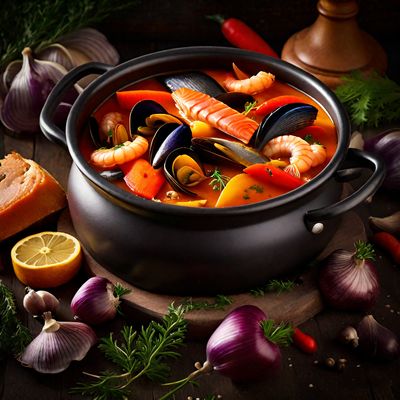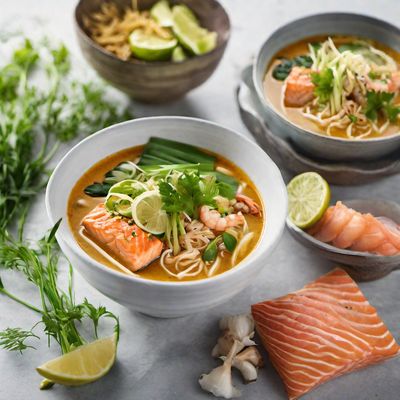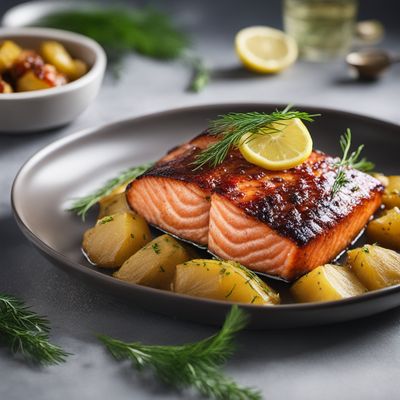
Ingredient
Atlantic salmon
The King of the Sea
Atlantic salmon is a species of fish that is native to the Atlantic Ocean. It has a firm yet tender flesh with a vibrant pink color. Its flavor is mild and buttery, with a hint of sweetness. The texture is smooth and velvety, making it a favorite among seafood lovers. Atlantic salmon is versatile and can be prepared in various ways, such as grilling, baking, or poaching.
Origins and history
Atlantic salmon has a long history of being an important food source for indigenous peoples in the Atlantic region. It has been a staple in their diets for centuries. In modern times, Atlantic salmon is commercially farmed in countries like Norway, Scotland, and Canada. Its popularity has spread worldwide due to its delicious taste and nutritional benefits.
Nutritional information
Atlantic salmon is an excellent source of high-quality protein, omega-3 fatty acids, and vitamin D. It is also rich in B vitamins, potassium, and selenium. A 3-ounce serving of cooked Atlantic salmon provides around 206 calories.
Allergens
Fish
How to select
When selecting Atlantic salmon, look for fillets or steaks that are firm, moist, and have a vibrant pink color. The flesh should be shiny and free from any discoloration or strong fishy odor. If buying a whole fish, the eyes should be clear and bulging, and the gills should be bright red. Fresh Atlantic salmon should have a mild, oceanic smell.
Storage recommendations
To keep Atlantic salmon fresh, store it in the coldest part of your refrigerator, ideally at a temperature between 32°F and 38°F (0°C and 3°C). Keep it wrapped in plastic or aluminum foil to prevent any odors from contaminating the fish. If you're not planning to use it within a day or two, consider freezing it for longer storage. Properly stored, frozen Atlantic salmon can maintain its quality for up to three months.
Preparation tips
Atlantic salmon can be prepared in various ways, such as grilling, baking, broiling, or poaching. For grilling, season the fillets with salt, pepper, and your choice of herbs or spices. Cook them over medium-high heat for about 4-6 minutes per side, until the flesh flakes easily with a fork. When baking, preheat the oven to 400°F (200°C) and place the seasoned salmon on a baking sheet. Bake for 12-15 minutes, or until the fish is opaque and flakes easily. To poach, bring a flavorful liquid, such as broth or wine, to a simmer in a wide pan. Gently place the seasoned salmon fillets in the liquid and cook for about 10 minutes, or until the fish is cooked through. Serve with your favorite side dishes or sauces.
Substitutions
Rainbow trout, Arctic char, Coho salmon
Culinary uses
Atlantic salmon is commonly used in a variety of dishes, including sushi, sashimi, grilled salmon fillets, salmon burgers, and smoked salmon. It is also a popular choice for salads, pasta dishes, and seafood chowders. Its versatility allows it to be paired with a wide range of flavors and ingredients, making it a favorite among chefs and home cooks alike.
Availability
Atlantic salmon is commonly available in countries such as Norway, Scotland, Canada, and the United States. It is also exported to many other countries around the world.
More ingredients from this category
Recipes using Atlantic salmon » Browse all

Bavarian-style Grilled Fish
Bavarian Delight: Grilled Fish with a Twist

Ahima’a Roasted Salmon with Maple Glaze
Pacific Delight: Maple-Glazed Ahima’a Salmon

Bouillabaisse
Baltijas Brīnumzivju Zupa (Baltic Wonderfish Soup)

New Nordic Laksa
Nordic-Inspired Laksa: A Fusion of Malaysian and Scandinavian Flavors

Wafu Teriyaki Salmon
Umami Delight: Wafu Teriyaki Salmon - A Fusion of Japanese Flavors

Torkarebl - Swedish Herb-Crusted Salmon
Nordic Delight: Herb-Crusted Salmon with a Swedish Twist

Saumon à l'oseille with Lemon Butter Sauce
Luscious Lemon Butter Salmon with a Tangy Twist

Grilled Teriyaki Salmon with Sesame Ginger Glaze
Savory Delights: Grilled Teriyaki Salmon with a Twist

Spanish-style Cider Salmon
Savory Salmon Delight: Spanish Cider Infusion

Lingonberry-Glazed Salmon with Dill Potatoes
Nordic Delight: Lingonberry-Glazed Salmon with Dill Potatoes

Salmón en Sidra Note by Note
The Symphony of Salmon: A Note by Note Culinary Masterpiece

Kingyoku - Japanese-style Grilled Salmon
Sakura Salmon Delight - A Flavorful Grilled Delicacy from Japan
